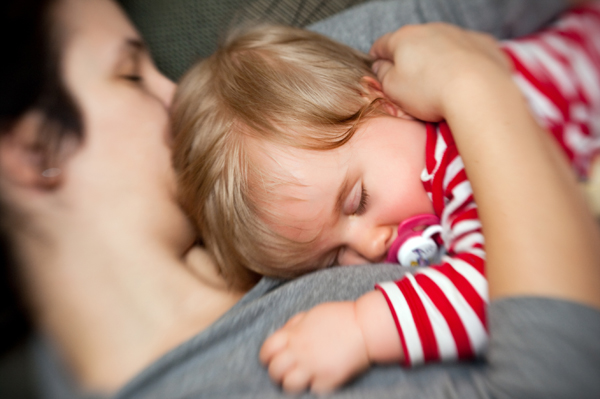Newborn and Mom Co-Sleeping Study Stirs Controversy

The question of whether newborns should sleep alone or with their mothers — where skin-to-skin contact can be maintained — continues to raise controversy, with a small new South African study contradicting American guidelines that recommend against co-sleeping, because of its link to Sudden Infant Death Syndrome.
Scientists from the University of Cape Town found that separating new babies from their mothers proved physiologically stressful for infants, causing significantly more "anxious arousal" and less "quiet sleep."
The researchers measured heart rate variability in 16 2-day-old sleeping babies for one hour, during both skin-to-skin contact with their mothers — where they were placed prone on their mother's bare chest — and alone in a cot next to their mother's bed. Heart rate variability measures how irregular the intervals between heartbeats are, and is considered an effective, non-invasive way to measure stress levels.
"What is desirable for newborns is to have 'sleep cycling,' which means an even distribution between active sleep and quiet sleep, in periods of about one hour," said Dr. Nils Bergman, a co-author of the study. "In our study, sleep cycling in separated babies was mostly absent, and in six of 16 babies that did show some quiet sleep when separated, it was shorter and shallower."
Born to snuggle with mom?
Bergman said that while skin-to-skin contact may be viewed as a novel intervention, "it is actually the only possible place for any newborn from an evolutionary biology perspective . . . and maternal (newborn) separation should be avoided."
But maintaining such close contact with infants, in "co-sleeping" arrangements with parents, can result in accidental suffocation and is strongly discouraged by the American Academy of Pediatrics.
Get the world’s most fascinating discoveries delivered straight to your inbox.
The AAP re-stated its opposition to the practice last month, in updated recommendations on Sudden Infant Death S risks. SIDS was the third leading cause of infant deaths in 2007 (the last year for which statistics are available), claiming more than 2,400 infants.
Risks and benefits
Dr. Rachel Moon, who authored the AAP's policy statement on SIDS and safe sleep, said skin-to-skin contact is not a problem in itself. "People say skin-to-skin is wonderful, and it can be . . . but it needs to be balanced," she said. "You need to be aware there are potential hazards, and know what the signs are if your baby is getting into trouble."
Moon said that mothers who want to practice skin-to-skin contact after birth should ask nurses to help monitor the babies while they do it, and be extremely mindful of not obstructing the infant's airway — a constant danger when sleeping next to an infant.
Moreover, the new study assumes that more "quiet sleep" for brand-new babies is beneficial, but that may not be true, said Moon, who is a pediatrician at Children's National Medical Center in Washington, D.C.
"Certainly, babies need to be able to sleep, but they also need to be able to wake up if they need to," such as if they're having problems getting enough oxygen, she said.
Bergman noted that several major health organizations, such as the World Health Organization and United Nations Children's Fund, support skin-to-skin contact for newborns. But using proper techniques is "vitally important," he said.
"Education should focus on ensuring co-sleeping is done safely," Bergman said. "Attempting to ban it is counterproductive. Parents whose infants are assertive enough to insist on this biological birthright, and then do not know how to do it safely, are thus endangered."
The study was published in the November issue of the journal Biological Psychiatry.
This story was provided by MyHealthNewsDaily, a sister site to LiveScience. Follow MyHealthNewsDaily on Twitter @MyHealth_MHND. Find us on Facebook.


